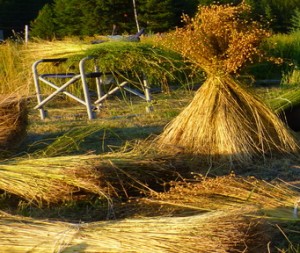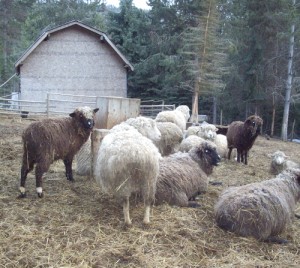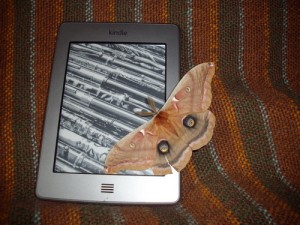Get to know the Big 4 Natural Fibers
This is a quick tutorial to help you understand the differences in the 4 major natural fibers. These are the natural fibers that are raised on farms around the world. They come to us from nature and only require spinning, and weaving or knitting to make them into clothing, adding colour is optional. Chemicals might be involved in the cleaning, dyeing, and laundering processes for the Big 4, but not in the manufacturing of the fiber itself – the exception being genetically modified cotton (gmo cotton). And the processing and the fiber can be done without industrial chemicals.
This is not an exhaustive list of natural fibers. This is not suggesting that these Big 4 natural fibers are better than other natural fibers that might be available in your native land, among your native species. These are the 4 natural fibers that have historical significance because economies have been built on their foundation. The Big 4 have had trade agreements, treaties, and wars fought over them. The Big 4 are the natural fibers you are most likely to encounter when you read garment labels. If you are a spinner, you will have an innate desire to master the Big 4. In fact, if you are a fiberartists, mastering the Big 4 will be on your bucket list, whether you are a weaver, a spinner, or a knitter.
Why natural fibers?
Natural fibers are renewable resources. If they are grown organically and sustainably, they enhance the lives of those who produce them, and those who purchase them to wear. Natural fibers decompose, naturally. They don’t give off plastic fibers in the washing machine, which are then flushed into the waterways and oceans of the world. Natural fibers breathe. They smell better. They make the people who wear them smell better. They act like a natural thermostat, wicking moisture away from the body, and cooling it in hot weather. They are insulating. One of these even reduces static and shocks in the environment and protects the wearer from the pain.
Linen
Linen grows on the outside of the stem of the flax plant. Linen-flax is a taller plant than oil seed flax, with smaller seeds. It was selectively bred to grow tall – over 4 feet high — and straight, with fewer flower heads. It is planted close together to inhibit stooling – where multiple stems come from the same root. It was traditionally processed on the farm by controlled rotting of the stem to dissolve the pectin holding the fibers together, called retting. Then the stem is crushed to release the fibers, called breaking. Then the long fibers are aligned through the teeth of spikey combs, called hackling, into a smooth hank ready for hand spinning. The process is time consuming, but no more time consuming than growing wool and cleaning and carding it for spinning.
There’s been a huge change in the linen industry since the economic crash of 2008. Today’s linen doesn’t even resemble the linen that was highly prized by humans over the last 4000 years of human history. Linen, by historical definition, must be at least 12 inches long to be labelled as linen. Today’s linen, however, has been chopped and chemicalized to reduce the length of the fiber. Once the linen has gone through the process of shortening, it can easily be processed using the same equipment used for cotton and wool. This process, called ‘cotton-izing’ is much cheaper than the traditional process. Cotton-izing allows an inferior tow-linen fiber to be combined with other naturally short fibers into blends.
You will see a lot of inexpensive dress shirts, with cotton-linen blends coming out of China in the last 5 years. The linen in these shirts is the shorter cotton-ized linen. This is why the shirts feel differently in your hands than the linen tablecloths your grandmother used to have. They lack the smoothness. They lack the sheen. And they lack the coolness, crispness, and longevity that true linen has.
If you can find linen that was processed in Europe – mostly Eastern Europe today – you might still find some traditionally processed linen that has a right to bear the name.
Train your hands to identify real linen and you will be ready to scour the thrift stores and consignment stores for natural linen clothing. Linen is a cooling fiber and is highly prized for wearing in hot climates.
Grow your own Linen
If you want to grow your own, you’ll need a plot of ground that you can easily weed by hand. You’ll need to go in when the plants are just 4 inches tall and weed the ground between each plant. You can safely step on the plants when they are between 4 and 12 inches tall and they will fully recover. If you fail to weed it well, your linen will be stunted and more difficult to harvest. So don’t plant more ground than you can weed by hand in a two week period.
Linen can grow well in most temperate climates and is frost hardy.
A unique trait of linen, and all bast fibers, is that it is stronger when wet. This made linen especially valuable for sails and ropes, when trade was centered on the sea and clipper ships.
Cotton
Cotton is a shorter fiber that grows around the seed of the cotton plant. It needs a long growing season and is found in most of the warmer areas of the world. Unfortunately, cotton has been genetically modified and is one of the heaviest sprayed crops in the world. Most cotton that you find in clothing has been grown with conventional agriculture, massively chemicalized during processing, dyeing, and laundering, and isn’t as “natural” as the textile industry would have you believe.
Finding non-GMO Cottons
It is still possible to get natural, organically grown, non-gmo cotton in the world. But it is rare and you will need to hunt for it. Sally Fox, a scientist and cotton grower in California, has grown organic, coloured cottons and has the fiber available to hand spinners, under the Foxfibre™ brand. In South America, it is possible to find naturally coloured organic cotton growing wild.
If you are growing your own, make sure your seed is non-gmo. If it is a gmo variety or if it has been contaminated with GMOs, you will not be able to save the seed, and it may even be illegal for you to grow it. You will need a long growing season, so in a cooler climate, consider growing it in a pot or in a greenhouse, so that you can control the temperature more easily.
Once the seed heads open, you harvest the cotton bolls and process the cotton by separating the cotton from the seed heads. You can run the seed heads through a roller to improvise a “cotton gin”, in order to separate the fibers from the seeds. Once the fibers are separated they need to be carded into a roving or hand carded into a punis, to be ready to spin.
Qualities of cotton textiles
Since the cotton fibers are much shorter than other natural fibers, the spinning process is different than spinning wool, a medium length fiber, or linen, and extra-long fiber.
Cotton is a weak fiber and tends to wear out quickly – think of how long a pair of work jeans lasts and you’ll understand the difference that fiber length makes in the durability of a fabric. Work jeans were originally made from linen or hemp, another bast fiber, similar in many ways to linen.
Cotton lacks elasticity and tends to wrinkle if not treated with chemical surface coatings. It is also flammable.
Wool
Wool is the fibre that is grown on the backs of sheep around the world. While some sheep breeds, such as the Katahdin, and the Barbados black belly grow hair, rather than wool, and do not need to be sheared each spring. Sheep bred for wool production such as the Romney, or the Rambouillet sheep at Joybilee Farm, grow their lustrous, soft coats only to be sheared in the spring.
Breed differences of sheep
Different breeds of sheep have different wool quality. Most consumers are familiar with merino wool. The merino is a sheep breed, historically from Spain that was raised specifically to provide very soft, elastic wool for next to the skin wear. The wool has a short staple and doesn’t wear well. But it is soft. The Rambouillet sheep are cousins of the merino, with similar fleece, but bred on the North side of the Pyrenees Mountains in France. There are also sheep that have lustrous, long wool that takes dye with a glow. Many of these wools were originally bred for the British textile industry for carpets, draperies, and outwear. The Romney breed was originally bred for this kind of wool.
When selecting wool for crafting, the end product that you intend to create is your most important consideration when choosing which fleece to use. Hand-spinners can get carried away with sheep lust, rubbing their hands through greasy fibers and becoming intoxicated with the natural eu de laine fragrance. But sensible crafters will choose fleece with an end product in mind.
Processing wool for crafting
Wool fleece must be washed, teased, carded or comb and spun into yarn to get it ready for weaving or knitting. If the wool is to be used for felting, the spinning is omitted. But not all wool is suitable for felting, so always test a sample before committing to a project.
Should you raise your own?
Economically, it is much less expensive to buy wool fleece than it is to raise the sheep yourself. On average a very good quality wool fleece that is well skirted can be bought for $10 to $15 per lb. The average wool fleece after heavy skirting weighs about 5lbs. On the other hand, the cost to feed a ewe for a whole year is about $225 – including hay and grain, if the ewe is on pasture for ½ the year. This does not include manpower or housing costs, nor the value of rented pasture land, or the cost of livestock guardians and veterinary bills. This is just something to consider when evaluating whether you want to add sheep to your homestead or just buy your wool for spinning and felting.
Textile Qualities of wool
Wool is the queen of fibers. All other fibers are compared to wool, when being evaluated for qualities. Wool is insulating. It wicks moisture away from your skin. It resists soiling. It is naturally antibacterial so it helps you smell fresh and attractive, even when you are doing heavy exercise. Many ski under-layers are made with merino wool for this reason. Wool has memory and elasticity. The long lustre wools take dye beautifully. Many wools will felt, allowing you to control other aspects of the fiber, such as water repelling properties and wind proofing. Many traditional textile techniques have their origins in wool, such as carpet weaving, tapestry, crewel embroidery, and rug hooking. But the most important quality of wool is that it remains insulating even when damp. Wool can absorb 4 times its weight in water and still retain its insulating properties. For this reason, consider adding wool blankets and wool undergarments to your winter preparations.
Washing Instructions
Wool has special washing needs and generally should be washed by hand or on the delicate cycle of your washing machine. I generally tell people to hand wash wool in warm water, rinse in warm water, towel dry and hand to dry at room temperature. Wools most destructive enemy is the domestic wool moth. Keep wool clean and moth free and it will last for years.
Silk
Silk is affectionately called worm spit, by spinners. Originally from the Orient, silk was traded along the trading routes of the Middle East and Europe for at least 3,000 years. Silk is the sticky thread that makes up the cocoon of the silk caterpillar. Traditionally silk moth eggs hatched on leaves and then were fed, by the women and children in a household. The silk that we are familiar with comes from the Bombyx Mori silk moth, that feeds exclusively on mulberry leaves. Leaves are chopped and brought to the silk worms several times a day, while the caterpillar grows through 5 instars, where it sheds its skin and grows to the next stage. At the final stage it spins a cocoon.
Harvesting silk
Small farmers will harvest the crop by stifling the pupa inside the cocoon with steam. While some moths are allowed to complete their lifecycle, the cocoon is damaged in the process, as the moth dissolves the cocoon with its saliva in order to emerge and lay its eggs. Those cocoons that are steamed are then reeled into silk thread and the thread is sold in the market to weavers. The pupae are either fed to chickens or eaten by the family, as a rich, fatty protein source.
Many different species of silk moths exist, each feeding on their own special plants. In North America there are several large moths in the silk moth family, including the polyphemus silk moth that feeds on willows and poplar trees. There is a lot of information on the internet about wild silk moths of North America. Several times businesses tried to exploit these moths to raise silk commercially in North America but it wasn’t economically viable. In Mexico, however, before the Spaniards, silk was raised and processed using a native silk moth, that is almost extinct. It was kept alive by some indigenous weavers, hidden from government eradication programs through the past 200 years.
Qualities of silk
Silk has different qualities depending on which country the silk moths are native to, and what the moths are fed. Tussah silk is a coarser silk than bombyx mori and is usually a honey gold colour because of the oak leaves fed to the caterpillars. Oak is rich in tannins which give the silk its characteristic colour.
Silk is highly prized as a fabric for clothing and household textiles. It is naturally electro-static, so it preserves people from getting electric shocks if worn next the skin. It is 4 times warmer than the same weight of wool. It is insulating and wicks moisture away from the skin. It is prized as an under-layer because it is naturally antibacterial, so people wearing it don’t stink, like when wearing manmade fibers as under-layers. Silk will keep you warm in winter and cool in summer.
Because silk is a long fiber, it has a beautiful sheen. It also has some elasticity, though it is not as elastic as wool. It takes dye beautifully because of its lustre. It also requires special care – low temperature ironing for instance to maintain its sheen. Heat will destroy the surface lustre in silk.
Should you grow your own?
It is possible to grow your own silk, although, this should be undertaken only as an educational exercise. Silk moth eggs are available in the USA through Worm Spit. Before you commit to this project, make sure you have a constant source of mulberry leaves, so that the caterpillars can grow to their full capacity. Lettuce has been recommended as a substitute, but it is an unnatural substitute. Silk moths require constant care as they go through their 5 instars, so plan it into your schedule before you begin the project.
Recap
The Big 4 Natural Fibers are the foundation of a sustainable wardrobe. Linen, and cotton are vegetable fibers and wool and silk are protein fibers. Vegetable and protein fibers are treated differently in the dyeing process and in the washing process. Protein fibers take dye more easily than vegetable fibers.
When shopping for clothes and accessories, check the labels and see if your clothing purchases reflect the sustainability of the Big 4. Advertisers will tell you that manmade fibers are a sustainable, and ethical choice because they want to sell you more manufactured clothing. Now you understand some of the issues and can make wiser, truly ethical choices when you purchase clothing and choose to make your own.






Hi guys I always check composition before I decide to buy my clothes. Unfortunately it’s not so easy to find clothes with natural materials in online stores. But recently I have found a website qualitago.com where you can find a lot of items made of cotton, silk and other natural or semi-natural fabrics from most common brands like Zara, AE or H&M. They show detailed composition, so you don’t have to click on every item to check if it’s 100% of cotton or 1%. They don’t have search engine unfortunately, but worth to check.
Good plan. I think you’ll really like http://www.wearingwoad.com, too. Sarah talks a lot about making ethical choices in our clothing.
Thanks for this post and information! I’ve always known cotton is one of the best fabrics and always really disliked polyester, but sometimes we just get stuck into buying what’s out there. I have decided to start replacing pieces slowly and getting only natural fiber clothing from now on! Its actually quite shocking how much clothing in most typical stores are basically plastic!